At Pallant House, a large case is filled with an assortment of objects: a glass stoppered decanter, a wide-rimmed blue-striped mug, a pewter dish, a jug with clay-red stripes, a tall thin-necked vase, several small rummer glasses. The objects – all English, mostly Victorian and Georgian – are arranged for perusal, as if Kettle’s Yard were having a sale and had set its wares out on trestle tables in the street. But they are not bric-a-brac: the objects belonged to Ben Nicholson, accumulated throughout his lifetime, taken with him from studio to studio, their lips and handles appearing and reappearing in his works. Nicholson had a collector’s impulse, an eye for the structural and material qualities of things. He preferred unfussy crockery: ale mugs and cider jugs in creamware or Staffordshire mochaware. His collection, wrote Jim Ede in 1930, was ‘most happily human’. He liked an object’s shape, its visible history of use. He once haggled a set of tools off a plumber, drawn to the elegant simplicity of old spanners, the scumbled patina of their surfaces, their lines and curves.
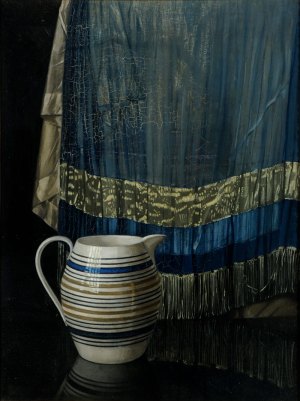
1914 (the striped jug) (1914), Ben Nicholson. University of Leeds Art Collection. © Angela Verren Taunt. All rights reserved, DACS 2021
In showing these objects alongside the paintings in which they appear, ‘Ben Nicholson: From the Studio’ proposes a new way of seeing the artist’s work. The exhibition suggests that the objects provide a narrative in miniature of the evolution of Nicholson’s style, and, perhaps, the changes he wrought to modern British art. It is a tentative suggestion; nothing is dogmatic here. The exhibition simply asks us to look, to observe the ways in which certain objects materialise again and again – this time an experiment in colour, this time in surface texture, this time in structure and form. It invites the pleasure of noticing a jug or bottle’s permutations across several works, and of encountering the object itself, old, chipped and scratched, almost talismanic, almost pathetic in its tangible form.
A large, portly cider jug banded with black, brown and blue appears in several paintings. In an early work from 1914, the jug is depicted in front of a drape, luminous against a darkened interior of olive greens and browns. When Nicholson painted it a decade later, in 1924 (painting—trout), he took only its stripes, flattening them to form a panel among several bright interlocking panels. The jug’s journey charts Nicholson’s own, from his rejection of opulent naturalism for the bold reductions, the whittling down of abstraction. ‘The more I think & see of ptg,’ he had written the previous year, ‘the more abstract stuff interests me to the exclusion of all else.’ Other jugs became the focus of his experiments. In 1928 (striped jug and flowers), which veers back towards figuration, Nicholson seems to follow his wife’s example (Winifred Nicholson was cultivating her light-filled bloomy still lifes in the Cumbrian farmhouse they shared) and yet is more interested in the jug’s structure, its jutting handle, its bands of colour. In 1948 (still life), another jug is studded with black and white cat’s eyes like its Staffordshire original, yet with its handle cut out and repeated like a loose ear. Nicholson was busy pulling apart his objects at their joints, separating out their constituent parts. Elsewhere, the patterns on his crockery – striated, chequerboard, geometric – float freely among abstract shapes.
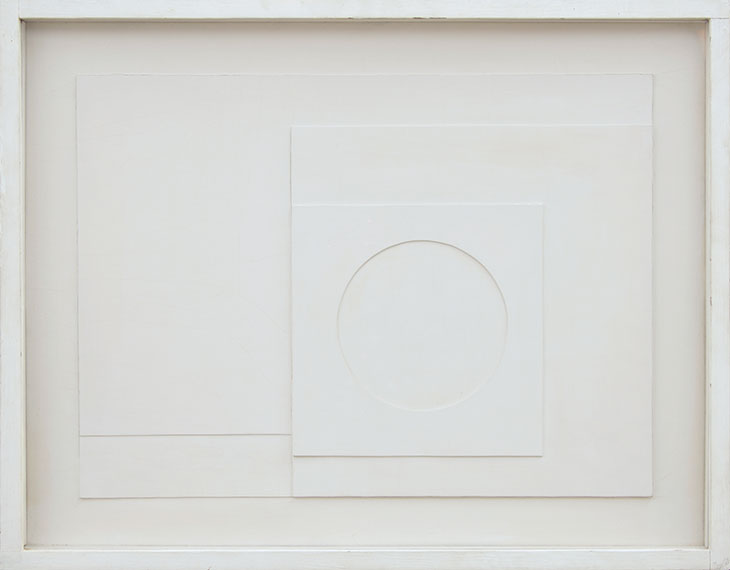
1936 (white relief) (1936), Ben Nicholson. Private collection (on loan to Pallant House Gallery). © Angela Verren Taunt. All rights reserved, DACS 2021
The artist’s boldest moment came in 1933, when he carved his first relief in wood. A relief from 1936 is shown in the gallery alongside a slender ceramic vessel, a dialogue of circles in purest white. Yet after he moved to Cornwall with Barbara Hepworth in 1939, it seems Nicholson withdrew from the total abstraction of the previous decade in favour of a surreally hybrid style, one that merged still life with landscape painting. In his Cornish harbour scenes, jugs and vessels jostle as if standing, larger than life, on the beach at Mousehole; or the crockery is incorporated into the architecture of the town, the mugs as squat buildings, the neck of a tall vessel protruding like a church tower. The objects are tightly packed like the small fishing villages themselves. Groupings of things were always Nicholson’s starting point: ‘My “still life” paintings are closely identified with landscape,’ he observed in 1957, ‘more closely than are my landscapes which perhaps relate more to “still life”.’

Glassware, jugs and mugs from Ben Nicholson’s studio. Photo: Barnaby Hindle
In a final room, Nicholson’s later works, from the 1950s until the 1970s, seem to have been peeled back to their first skins, gleaming green, cream and white. There is a shelf of English glassware on display: a soda bottle, a two-handled bowl, a ewer, a firing glass, a decanter with a stopper in the shape of a spire. Nicholson’s lines become very clean. In May 1955 (green chisel), the forms overlap against a background of bluish stone; in 1972 (stoppered vase and goblet), three vessels are separate yet connected, their intersections creating spaces inside themselves. How many forms are there, three or more? Only the decanter’s stopper remains whole, floating like a doorknob or a lightbulb.
Does an exhibition like this risk simplifying Nicholson’s work to its domestic roots? In St Ives, Hepworth has a permanent museum devoted to her overalls and tools. Rather, the many photographs of Nicholson’s studios demonstrate the care with which a mantlepiece was arranged. The objects are by now familiar: the portly jugs, the tall mugs, the bottles and decanters. Nicholson lived alongside them, worked with them. They were present, acting as prompts, conduits into his experiments with colour and form.
‘Ben Nicholson: From the Studio’ is at Pallant House Gallery, Chichester, until 24 October.
Unlimited access from just $16 every 3 months
Subscribe to get unlimited and exclusive access to the top art stories, interviews and exhibition reviews.

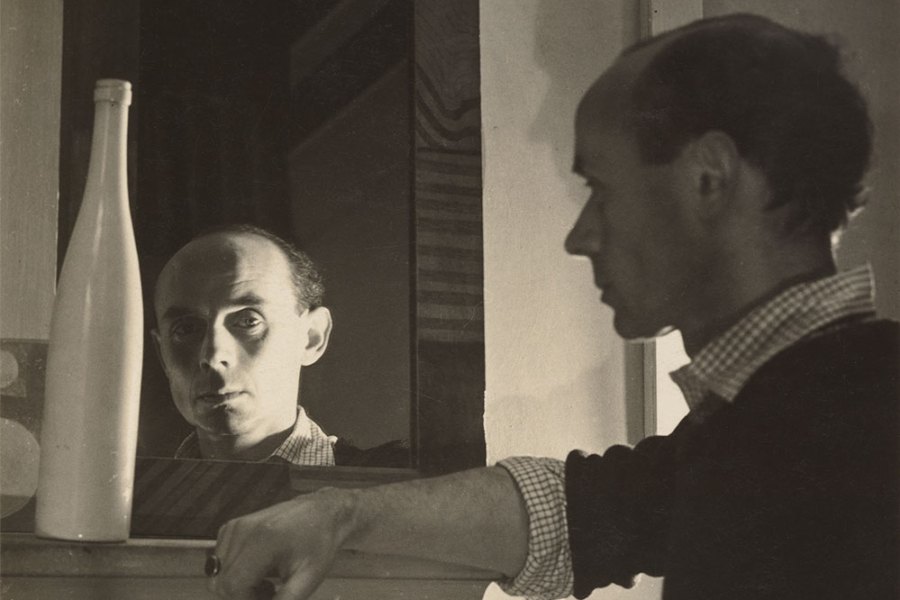
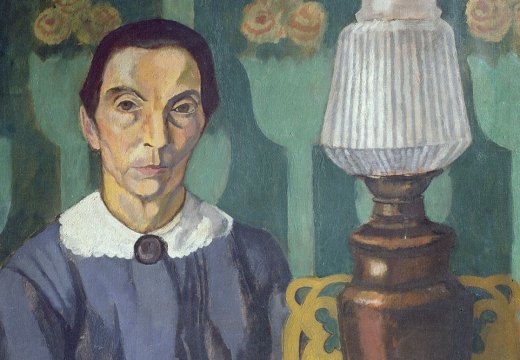
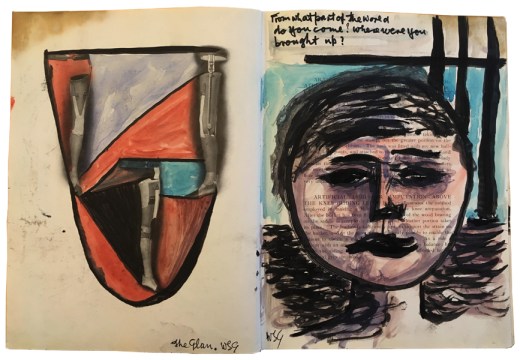
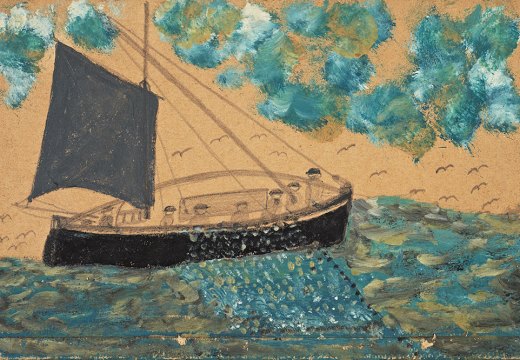









![Masterpiece [Re]discovery 2022. Photo: Ben Fisher Photography, courtesy of Masterpiece London](http://www.apollo-magazine.com/wp-content/uploads/2022/07/MPL2022_4263.jpg)
Why are fathers so absent from art history?